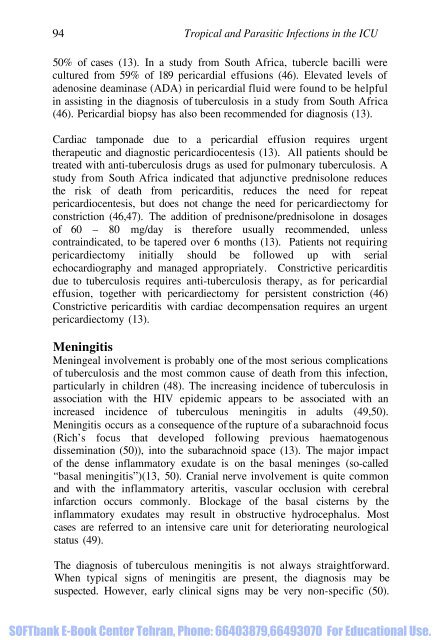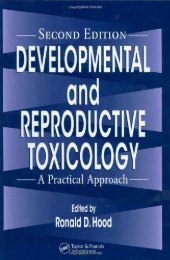SOFTbank E-Book Center Tehran, Phone: 66403879,66493070 For ...
SOFTbank E-Book Center Tehran, Phone: 66403879,66493070 For ...
SOFTbank E-Book Center Tehran, Phone: 66403879,66493070 For ...
You also want an ePaper? Increase the reach of your titles
YUMPU automatically turns print PDFs into web optimized ePapers that Google loves.
94 Tropical and Parasitic Infections in the ICU<br />
50% of cases (13). In a study from South Africa, tubercle bacilli were<br />
cultured from 59% of 189 pericardial effusions (46). Elevated levels of<br />
adenosine deaminase (ADA) in pericardial fluid were found to be helpful<br />
in assisting in the diagnosis of tuberculosis in a study from South Africa<br />
(46). Pericardial biopsy has also been recommended for diagnosis (13).<br />
Cardiac tamponade due to a pericardial effusion requires urgent<br />
therapeutic and diagnostic pericardiocentesis (13). All patients should be<br />
treated with anti-tuberculosis drugs as used for pulmonary tuberculosis. A<br />
study from South Africa indicated that adjunctive prednisolone reduces<br />
the risk of death from pericarditis, reduces the need for repeat<br />
pericardiocentesis, but does not change the need for pericardiectomy for<br />
constriction (46,47). The addition of prednisone/prednisolone in dosages<br />
of 60 – 80 mg/day is therefore usually recommended, unless<br />
contraindicated, to be tapered over 6 months (13). Patients not requiring<br />
pericardiectomy initially should be followed up with serial<br />
echocardiography and managed appropriately. Constrictive pericarditis<br />
due to tuberculosis requires anti-tuberculosis therapy, as for pericardial<br />
effusion, together with pericardiectomy for persistent constriction (46)<br />
Constrictive pericarditis with cardiac decompensation requires an urgent<br />
pericardiectomy (13).<br />
Meningitis<br />
Meningeal involvement is probably one of the most serious complications<br />
of tuberculosis and the most common cause of death from this infection,<br />
particularly in children (48). The increasing incidence of tuberculosis in<br />
association with the HIV epidemic appears to be associated with an<br />
increased incidence of tuberculous meningitis in adults (49,50).<br />
Meningitis occurs as a consequence of the rupture of a subarachnoid focus<br />
(Rich’s focus that developed following previous haematogenous<br />
dissemination (50)), into the subarachnoid space (13). The major impact<br />
of the dense inflammatory exudate is on the basal meninges (so-called<br />
“basal meningitis”)(13, 50). Cranial nerve involvement is quite common<br />
and with the inflammatory arteritis, vascular occlusion with cerebral<br />
infarction occurs commonly. Blockage of the basal cisterns by the<br />
inflammatory exudates may result in obstructive hydrocephalus. Most<br />
cases are referred to an intensive care unit for deteriorating neurological<br />
status (49).<br />
The diagnosis of tuberculous meningitis is not always straightforward.<br />
When typical signs of meningitis are present, the diagnosis may be<br />
suspected. However, early clinical signs may be very non-specific (50).<br />
<strong>SOFTbank</strong> E-<strong>Book</strong> <strong>Center</strong> <strong>Tehran</strong>, <strong>Phone</strong>: <strong>66403879</strong>,<strong>66493070</strong> <strong>For</strong> Educational Use.





